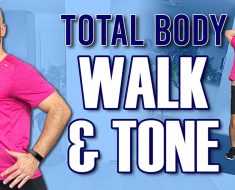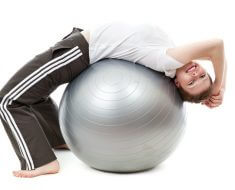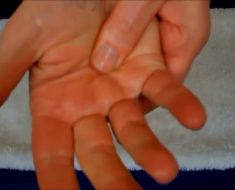♪ ♪ GINA BITER-MUNDT:
We all know how important it is to stay physically fit and without regular exercise our muscles will not perform to the best of their ability. Exercise ensures
that we maintain good strength and endurance
to lead full and active lives. In this video
we will guide you through a 25-minute aerobic exercise
program and a series
of resistance exercises. As you will see the participants have varying levels of spinal cord injury and if you choose you may follow the person
who most closely demonstrates your functional ability. When you incorporate exercise into your daily routine you'll experience many benefits. You'll have improved
self-esteem and self-confidence. It will increase your ability
to take care of your activities of daily living. It will decrease
your LDL cholesterol which is your bad cholesterol and it will increase
your HDL cholesterol which is the
good cholesterol and it will provide
for some social interaction. The American College of
Sports Medicine recommends that you exercise three days a week at 50 to 80 percent
of your max heart rate.
To determine your max heart rate you take 220 minus your age
and there you go. An alternative way to measure your exercise intensity is to use the Borg RPE scale which can help you evaluate your rating
or perceived exertion. This is a sliding scale where
6 is no exertion at all and 20 is maximal exertion. The target zone for aerobic exercise using this scale is between 9 and 14. If during the workout you feel that you are only at a 7 or an 8 that means that you're not working at your full potential. Try to use more of your body and pick up your speed if you can. If you feel like
you're at a 14 or above and are exerting too much energy slow down your movements and make your movement
patterns smaller.
One more way to measure
your exercise intensity is by using the talk test. If you can carry on
a conversation while exercising you're doing just fine. But if you're having trouble talking while exercising that means you're exercising
a little bit too hard and you need to
decrease your intensity by making your movement
patterns a little bit smaller and maybe decrease your speed
a little bit. So here are a few things
you may want to think about before you start exercising. You may want to use a way strap or a trunk strap to maintain good balance.
And another thing, if you have a spinal cord injury at T6 or above you may have problems
regulating your body temperature so have a spray bottle or a damp cloth close by
to keep you cool. To prepare for exercise have your resistance equipment close by, have a water bottle on hand
to stay hydrated, secure any strapping devices
you may use to maintain good posture, lock your wheelchair brake
so your wheelchair doesn't roll, and if you have arm rests
on your wheelchair and your functional balance
allows take those arm rests off. If at any time
during the exercise session you experience pain
or discomfort either modify your movements
or stop altogether and if the pain persists you may want to
consult with your physician. GINA BITER-MUNDT:
Hi, I'm Gina Biter-Mundt and I'm the
Adaptive Sports Consultant at Kaiser Foundation Rehabilitation Center in Vallejo, California.
And I'm joined here today with Sebastian, Cleveland, Mark, and Richie, and we're here
to do an exercise program so let's get started. We're going to slowly
warm up your muscles before our aerobic workout. Sit up straight. If you need to wear chest strap for balance please do so. Take a nice big deep breath
in and out. And again
breathe in and out. And again
breathe in and out. Now look over your
right shoulder. And to the left. Bring your head back to center. Tip your ear to your shoulder. And to the other side. Bring your head
back up to center and let's do shoulder rolls. Shrug them up
and roll them back. It's important to focus
on rolling your shoulders back because your shoulders
tend to roll forward from pushing your wheelchair. ♪ ♪ Now hang your right arm
down to the side and circle it. ♪ ♪ And the other direction. Now your left arm to
the side and circle it. And the other direction. And do some nice
big arm swings. And reach forward
one arm at a time. Stretch it out
as far as you can. If at any time
during this exercise program you experience pain, stop
and consult with your physician.
Now shoulder press
over the head. Reach one arm over your head. Extend it up as high as you can. And bicep curls,
arms together, extend them down at your side. Flex your arms up so your hands are coming up shoulder height. And triceps,
hold your elbows up high, push your hands back. If you have limited
or no use of your triceps because of your level of
spinal cord injury and need to modify it extend your arms down and externally rotate your hands locking your arms out. And lateral raises,
arms bent. ♪ ♪ And shoulder rolls. Shrug them up
and roll them back. Bicep curls, alternating. ♪ ♪ And lateral raises,
arms straight. ♪ ♪ And pulse it back. ♪ ♪ Shoulder shrug,
shrug them up and down. You should be getting
warmed up and ready for our aerobic part
that's coming up so take it into a jog.
Remember to stay safe and exercise at your own pace
and functional ability. ♪ ♪ And bounce your hands
at the side nice and high. Make sure you're
sitting up straight. And bounce them
forward and back. And cabbage patch,
circle it around. This may challenge your balance a little bit. And circle the other direction. Do as much as you can. All of this will help with
your overall conditioning. Now hold your elbows up high, push those hands out
to the side. ♪ ♪ And let's take it into some bicep curls, alternating. ♪ ♪ And front rows, extend the arms
out in front of you, pull them back and squeeze
those shoulder blades together. If you need to modify this
or any movement modify it so you get as much out of your movement pattern as you can while still
maintaining good balance.
♪ ♪ And roll it. ♪ ♪ Reverse your direction. ♪ ♪ And lateral raises,
arms bent. ♪ ♪ We're coming into our first intensity check. How are you doing? So take it into a jog. Remember that intensity scale? Where are you on
that scale right now? Put some good
energy into this. ♪ ♪ And jumping jacks. Extend those arms up
as high as you can. ♪ ♪ Getting warmed up yet? Imagine like you're in
a nice cool pool and swim it out, breast stroke. ♪ ♪ And upper cuts,
cross it over and punch it. ♪ ♪ And tricep pushbacks. Again, if you need to
modify this go ahead. Make sure you get as much
out of your movement. ♪ ♪ And shoulder press, both arms up over the head
as high as you can go. And front reach, reach it as far as you can. ♪ ♪ And bicep curls, together. If you're getting tired
take it into a jog. Just keep yourself moving. And up, out to the side. ♪ ♪ And reverse it. Push those hands out. We're almost at our
next intensity check. Keep it going. Just a few more. And take it into a jog.
Here is your intensity check. How are you doing? ♪ ♪ And front rows, reach forward
and pull them back. ♪ ♪ And jumping jacks. ♪ ♪ And upper cut. ♪ ♪ And taking in some high elbows. Push those hands out
to the side. This will get easier
the more you do it. Try and do some form of
aerobic exercise at least three days a week. ♪ ♪ And take it into a jog. Remember, exercise is work
and you may experience a little discomfort
and pain but that's normal but if it persists
longer than a few days consult with your physician. ♪ ♪ Front raises, extend the arm out
in front of you, raise your hand up
about shoulder height. ♪ ♪ And karate chops, hold your elbows up
nice and high, extend those hands out in front, and alternate. ♪ ♪ And lateral raises,
arms straight. ♪ ♪ You have been working
really hard. You will feel better
as soon as we're done. You're doing great. And take it into
some apple-picking. Reach up and pull your hand down as if you're putting it in
a pouch at your opposite side.
♪ ♪ And switch to
the other side. ♪ ♪ Now arms open and close,
nice and fast. ♪ ♪ And take it in a diagonal. It's important to do exercise
on a regular basis. It will help increase
your endurance and your ability to perform
your activities of daily living. The easier it is to perform your activities of daily living the more time you have to spend with family and friends. And single arm,
swim it out to the side. ♪ ♪ And take it into a jog. This is our last
intensity check. How are you doing? Did you reach
your target number? ♪ ♪ Come on, keep it going,
up and down. That's it, keep it going. ♪ ♪ And we're going to start
slowing it down now. Reach forward
one arm at a time. Slow it down so your heart rate can come down a little bit.
♪ ♪ And lateral raises,
arms bent. ♪ ♪ And bicep curls together. ♪ ♪ And bicep alternating. ♪ ♪ And pulse it back. ♪ ♪ Start slowing it down. ♪ ♪ And bounce your
hands at the sides. Imagine those basketballs. ♪ ♪ Now forward and back. ♪ ♪ Now let's take it into
some shoulder rolls. Doesn't that feel good? And reach down to the side, stretch, and to the other side. ♪ ♪ And back at the center,
shoulder shrugs up and down. And bring your arm across
your chest to stretch. Do some good deep breathing. Switch to the other side. Now put your hand on
your opposite knee. Twist to the side and stretch. And over to the other side. Bring yourself back to center and do a chest stretch.
Lean back, open up your chest, feel that stretch. And bring it back,
nice slow arm swings. And take a nice big
deep breath in and out. And again
breathe in and out. And again
breathe in and out. You did a great job. If you do this a couple times
a week it will get easier and you'll feel the effects almost immediately. ♪ ♪ TODD TANNER:
Hi, I'm Todd Tanner. I'm a physical therapist
and I work at Kaiser Foundation
Rehabilitation Center in Vallejo, California. Strength and resistance training are vital to maintaining your musculature allowing you
to perform everyday activities. In this portion of the program we're going to demonstrate strengthening and resistance exercises aimed at strengthening
the shoulder, the trunk, the upper arm depending on
your level of injury. These exercises
are very important to maintain symmetry of the body and hopefully hold off potential harmful muscle imbalances. We will show these exercises being performed with no weight, cuff weights, free weights, or resistance tubing.
The tubing is very good because you can vary
your level of resistance depending on your recovery and you can take it
anywhere you need to go. The various colors of
the tubing or bands identify
the amount of resistance. There are four things
to consider when you're doing
an exercise program: the sets, the repetitions, the proper amount of weight, and the frequency by which
you do the program. A set is a number of repetitions done in a row. Now remember this is
based upon your ability. If you're stronger
start at 3 sets of 10. But if you're not do 3 sets of 5 and work your way up to it. Remember, in between each set take a break to allow your body to recover and prepare for the next set. Repetitions are the number
of times you perform an activity or an exercise. The number of repetitions
is based upon your ability and is usually set by
the physical therapist. It's important that when
you're doing your exercises that they're slow,
controlled, and using the appropriate
musculature. Remember it's more important
to have quality than it is quantity.
The amount of weight or resistance is usually expressed in pounds being moved. Again, it's important to pick
a weight that allows you to be smooth and controlled through your available range of motion. This is true whether using
no weight, cuff weights, free weights,
or the exercise tubing. Finally, frequency is the number of times a day or a week you should do
your exercise program. Research suggests
3 to 5 times a week is most effective. When you first start out
it's important to pick a weight or resistance that allows you
to move through your available range of motion smoothly and slowly. If you're unable to do
10 repetitions this way then the weight is too heavy.
Use a weight or resistance
that fatigues your muscles within 10 to 15 repetitions. Depending on your
functional ability you can try doing the exercises
with both arms simultaneously or you can have one hand stabilized while the other hand
performs the exercise. To start you want to bring your wheelchair onto a level surface. You want to lock your brakes. You want to sit up
to the best of your ability. Remember to exhale when
you're performing the exercise and inhale when you're returning back to the start position. In the beginning of
the rehabilitation process your strength may be
diminished and therefore you might not be able to use weight or resistance. Another reason why you
might not use resistance is your level of injury. In these cases just the weight of gravity itself will provide a training effect
during the exercises. The purpose of resistance training is to strengthen and maintain the
musculature of your shoulders enabling you to do
the activities of daily living.
An important activity is to do
a pressure relief off your backside to
allow for circulation and maintain
good skin integrity. You can do this by doing
a push-up in your wheelchair. Secure your brakes and
place your hands at your side either on your wheels
or on your arm rests. Position your head forward
while tucking the chin to help maintain proper balance and slowly push up lifting
your bottom off the seat cushion and hold it there. If you are unable
to lift yourself up you can perform pressure relief
by leaning to one side, getting your weight
off that side, and then switch
and lean to the other side. You can also perform
a pressure relief by leaning forward or backward.
If you have a power chair
that tilts back, then use that. All these positions
distribute the weight giving your pressure points relief. With time these exercises
will get easier and you'll have a good foundation to build both strength and endurance. I hope you view this as a bridge in regaining your independence and incorporate some form
of physical activity in your everyday life. Bicep curls target the muscles on the front side of your upper arm.
To perform bicep curls
with no resistance extend your arm down
at your side, bend at the elbow bringing your hand up to
your shoulder, then return to
the start position. It is important to keep
your elbow close to your body during the movement. Depending on your balance
you can alternate each side or do the movement
with both sides together. Elbow extensions work the tricep muscles which are found on the back side of your upper arm. To perform this exercise
with no resistance hold your elbow high so that it
points toward the ceiling, extend, then drop your
hand behind your head.
The movement should be
smooth and controlled in both directions. Lateral raises target
the deltoid muscles which are found
on the top of your shoulder. Lateral raises are performed by holding your arms
down at your side, lifting them out and away from your body to shoulder height or above. The movement should be done smooth and controlled throughout the entire
range of motion. Internal and external
rotation target key muscles in the stabilization
of your shoulder. Position yourself with
assistance as needed in your bed on your side. Your knees and hips
should be bent so that you do not roll
during the exercise. Start with your top arm
across your body, palm facing down,
the elbow bent to 90 degrees, and your upper arm in contact with your side. Lift the back of your hand
away from your body while maintaining the contact with your side.
The motion should be smooth and controlled in both directions and in an arc. Your shoulder should
maintain a stable position throughout the exercise. If the shoulder rolls out
then stop the exercise and reposition the shoulder
before continuing. If you cannot maintain
the shoulder then you should
skip this exercise. Save yourself extra work
and stay in this position to do internal rotation
of the bottom arm. Bend the arm approximately
90 degrees with the palm facing up, lift the hand up
towards your stomach. The movement should be
smooth and controlled in both directions. To perform this exercise
on the other side roll over and follow
the same directions. Bicep curls target the muscles on the front side
of your upper arm. To use tubing or a band
for bicep curls firmly secure the tubing or band through a part of your wheelchair below your feet or anchor to a stationary piece of furniture and position yourself
so the direction you pull is upward from the floor.
Begin with your arm in your lap and bend your arm at the elbow bringing your hand up
to your shoulder. This exercise is best performed one side at a time. It's important to hold on
with your other hand to stabilize your body. Elbow extensions work the tricep muscles which are found on the back side
of your upper arm. To perform the exercise you must first secure
the tubing above your head with assistance as needed to a door or other stationary object. Next, position yourself
so your back is to the door and take hold of the tubing. Start with your elbows
at shoulder height and extend your arms
straight out. Then return to
the starting position. The motion should be
smooth and controlled in both directions. Lateral raises target
the deltoid muscles which are found on the top
of your shoulder. To perform the exercise
with tubing or a band first position the wheelchair on top of the tubing or the band. Hold the tubing or band
in your hand with your arm fully extended
at your side.
With your palm down
lift up and away from your body to shoulder height or above. If you're unable to hold
the tubing or the band then perform the exercise
with the tubing or the band at the crease of your elbow. Chest press targets
the pectoralis muscles in your chest,
the triceps in the arm, and the anterior deltoid muscles
of the shoulder. To perform this exercise first wrap the tubing
around your back and underneath your armpits.
Grasp the end of the tubing
and simultaneously push forward extending both arms fully out
in front of your body. Exhale as you push forward and inhale as you
return to the start position. Front row targets the rhomboids and the middle trapezius which are the muscles
of your upper back. It also works the
posterior deltoids on the back of the shoulder
as well as the biceps in the upper arm. Secure the tubing to a door or stationary object
at shoulder height. Facing the tubing start with your arms extended out in front of you, pull back bending at the elbow and squeezing your
shoulder blades together. Ideally your elbow should be at shoulder height but not above.
If you cannot hold this posture then modify your arm position
to suit your abilities. While performing this exercise wear a chest strap for safety. Internal and external rotation target key muscles in the stabilization
of your shoulder. To perform this exercise
with tubing secure the tubing
to a door or stationary object at elbow height. Position yourself
on the side of the tubing making sure
you lock your brakes. Sitting up
as straight as possible begin with your elbow tucked in close to your side with your forearm
across your abdomen. Slowly move your hand out
and away from your body while maintaining your
elbow contact with your side and return to
the start position. This movement should be
smooth and controlled in both directions. You can remain in this position to perform internal rotation. Bicep curls target the muscles on the front side
of your upper arm. To perform bicep curls with resistance using a wrist cuff wrap the cuff around your wrist and secure it with the Velcro.
Start the exercise with your arms extended down at your side. Bend your arms at the elbow bringing your hands up to your shoulder height, then
return to the start position. Elbow extensions work
the tricep muscles which are found on
the back side of your upper arm. To perform this exercise
using a wrist weight secure the weight
around your wrist. Raise your hand behind your head bending at the elbow. Keeping your elbow
close to your head fully extend your arm
up in the air.
Then return to
the start position. The movement should be
smooth and controlled in both directions. Lateral raises target
the deltoid muscles which are found
on the top of your shoulder. Secure the weight to your wrist. With your arms at your side
and palms down lift up and away from
your body to shoulder height or above. The movement should be
smooth and controlled in both directions. Internal and external
rotation target key muscles in the stabilization
of your shoulder. Position yourself with assistance as needed in your bed on your side. Your knees and hips
should be bent so that you do not roll
during the exercise. With the weight
secured to your wrist start with your top arm across your body, palm facing down, the elbow bent to 90 degrees. Your upper arm should be
in contact with your side. Lift the back hand
away from your body while maintaining contact
with your side. The motion should be
smooth and controlled in both directions
and in an arc. Your shoulder should
maintain a stable position throughout the exercise. If the shoulder rolls out then stop the exercise and reposition the shoulder before continuing.
If you cannot
maintain the shoulder then you should
skip this exercise. Save yourself extra work
and stay in this position to do internal rotation
of the bottom arm. Bend the arm to
approximately 90 degrees with the palm facing up. Lift the hand up
toward your stomach. The movement should be
smooth and controlled in both directions. To perform this exercise
on the other side roll over and follow
the same directions. Bicep curls target the
muscles on the front side of your upper arm. To perform bicep curls
with free weights hold the weight in your hand with your arm extended
down at your side.
Bend your arm at the elbow bringing your hand up to
your shoulder height and then returning to
the start position. Elbow extensions
work the tricep muscles which are found on the back side
of your upper arm. To perform this exercise
using free weights grasp the free weight, raise your hand up and behind your head bending at the elbow keeping your elbow
close to your head and then fully extending
your arm up in the air. Then return to
the start position. The movement should be
smooth and controlled in both directions. Lateral raises target
the deltoid muscles which are found
on the top of your shoulder. Grasp the weight with your hand. With your arms at your side
and palms down lift up and away from your body to shoulder height or above.
The movement should be
smooth and controlled in both directions. Depending on your
functional ability you can try doing the exercises
with both arms simultaneously or you can have
one hand stabilized while the other hand
performs the exercise. Internal and external rotation target key muscles in the stabilization
of your shoulder. Position yourself
with assistance as needed in your bed on your side. Your knees and hips
should be bent so that you do not roll
during the exercise. Hold the weight in your hand and start with your top arm across your body, palm facing down,
the elbow bent to 90 degrees. Your upper arm should be
in contact with your side. The motion should be
smooth and controlled in both directions
and in an arc. Your shoulder should maintain
a stable position throughout the exercise. If the shoulder rolls out
then stop the exercise and reposition the shoulder
before continuing. If you cannot
maintain the shoulder then you should
skip this exercise. Save yourself extra work
and stay in this position to do internal rotation
of the bottom arm.
Bend the arm to
approximately 90 degrees with the palm facing up. Lift the hand up
towards your stomach. The movement should be
smooth and controlled in both directions. To perform this exercise
on the other side roll over
and follow the same directions. The purpose of resistance
training is to strengthen and maintain the musculature of your shoulders enabling you to do the activities
of daily living. An important activity is to do a pressure relief
off your backside to allow for circulation and maintain good skin integrity. You can do this by doing
a push-up in your wheelchair. To do this secure your brakes and place your hands at your side either on your wheels or on your arm rests. Position your head forward
while tucking the chin to help maintain proper balance and slowly push up lifting your bottom off the seat cushion and hold it there. If you're unable
to lift yourself up you can perform pressure relief
by leaning to one side getting your weight
off that side and then switch
and lean to the other side.
You can also perform
a pressure relief by leaning forward or backward. If you have a power chair
that tilts back then use that. All these positions
distribute the weight giving your pressure points relief. With time these exercises
will get easier and you'll have a good foundation to build both strength and endurance. I hope you view this as a bridge in regaining your independence and incorporate some form of physical activity in your everyday life..






